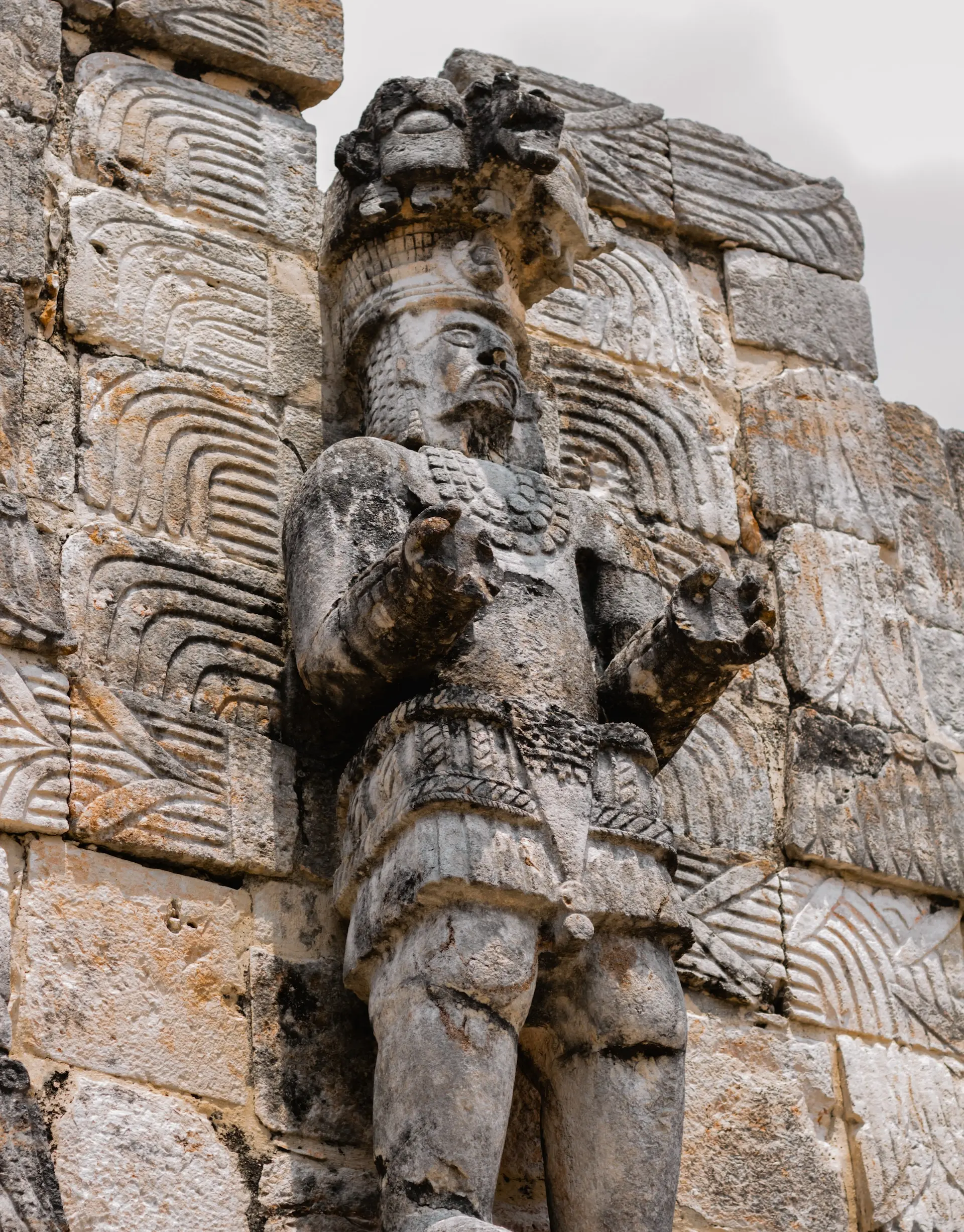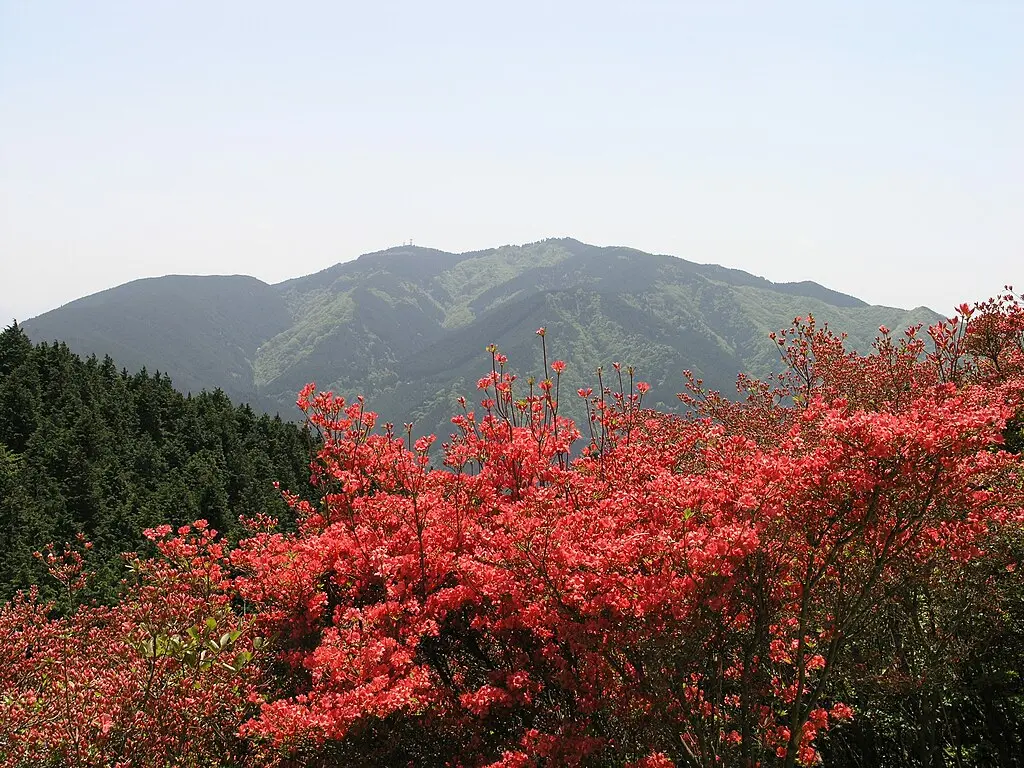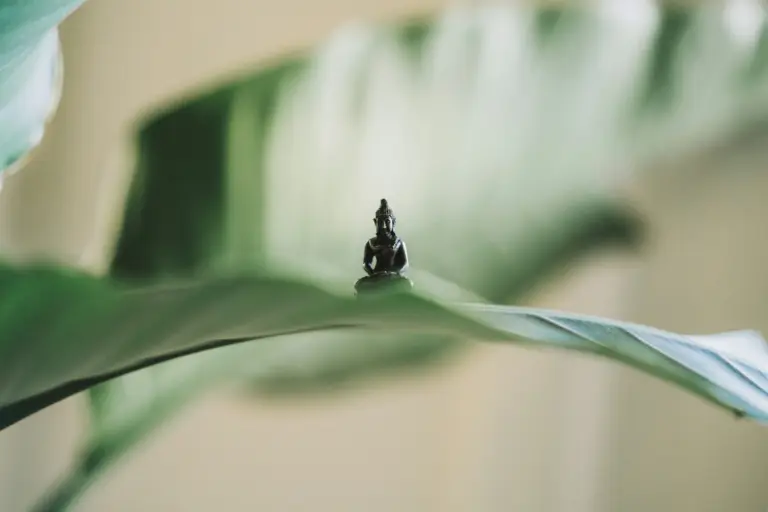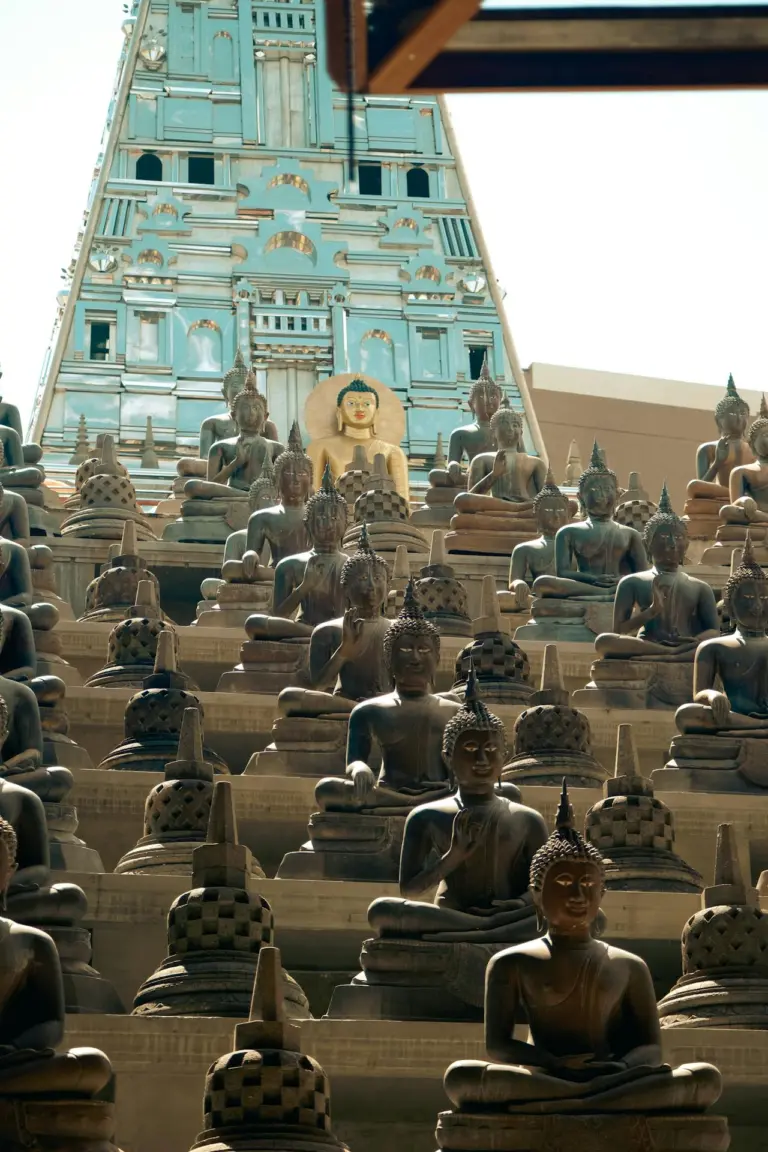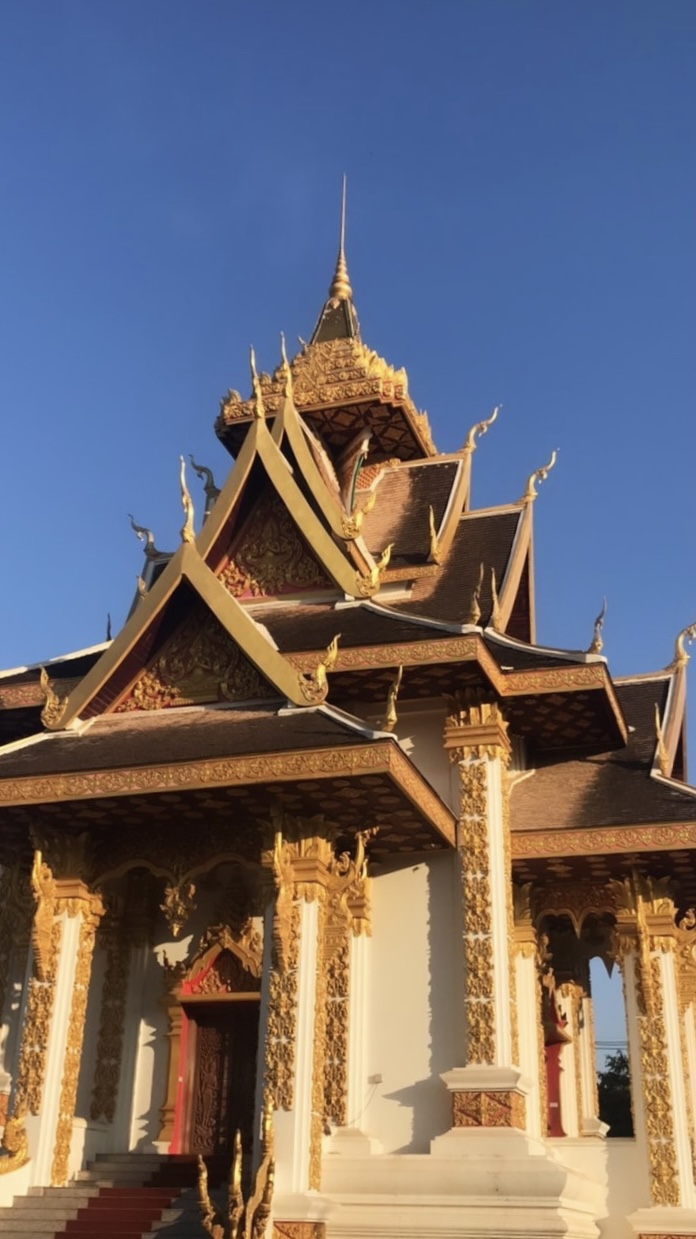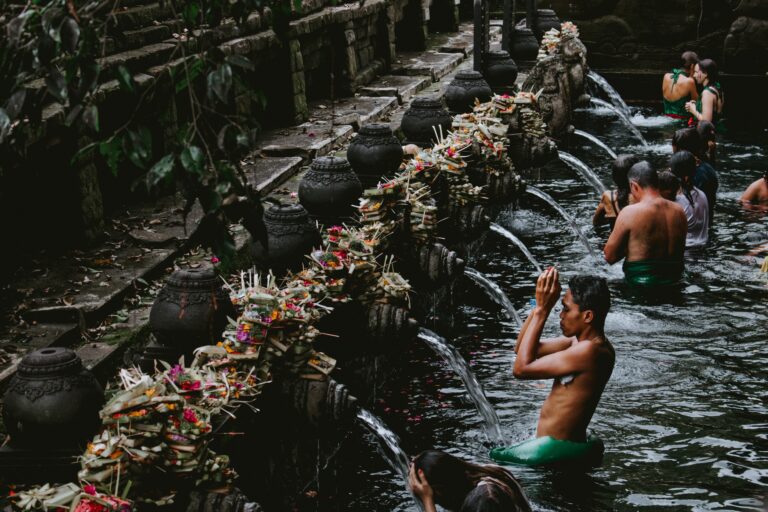Imagine starting your day with the sun rising over Sigiriya Lion Rock, spending your afternoon wandering through the cool, shadowy halls of the Dambulla cave temples, and then catching the day’s last light from atop Pidurangala Rock.
It’s a day trip that takes you through the heart of Sri Lanka’s majestic history and breathtaking landscapes, and it promises to be nothing short of unforgettable.
After all, Sigiriya isn’t just a rock; it’s a story set in stone. Rising dramatically from the plains, this ancient rock fortress was the brainchild of King Kashyapa in the 5th century. Climbing it is a walk through history, with every step taking you higher into the story of a king’s ambition and an island’s legacy.
A short tuk-tuk ride away, the Dambulla cave temples offer a serene counterpoint to the morning’s climb. These caves, filled with Buddha statues and murals, are a peaceful refuge that has drawn pilgrims for centuries. Each cave has its own vibe, from contemplative to grand, and stepping inside feels like entering a different world—one where time moves slower, and the present moment gains depth and color.
As the day fades, Pidurangala Rock calls. This climb is less about the destination and more about the journey—and, of course, the view at the end. Less polished but no less beautiful than Sigiriya, Pidurangala offers a rugged path to a breathtaking sunset. It’s the perfect spot to reflect on the day’s adventures, watching as the setting sun paints Sigiriya in golden hues, a silent silhouette against a sky ablaze with color.
Table of Contents
Toggle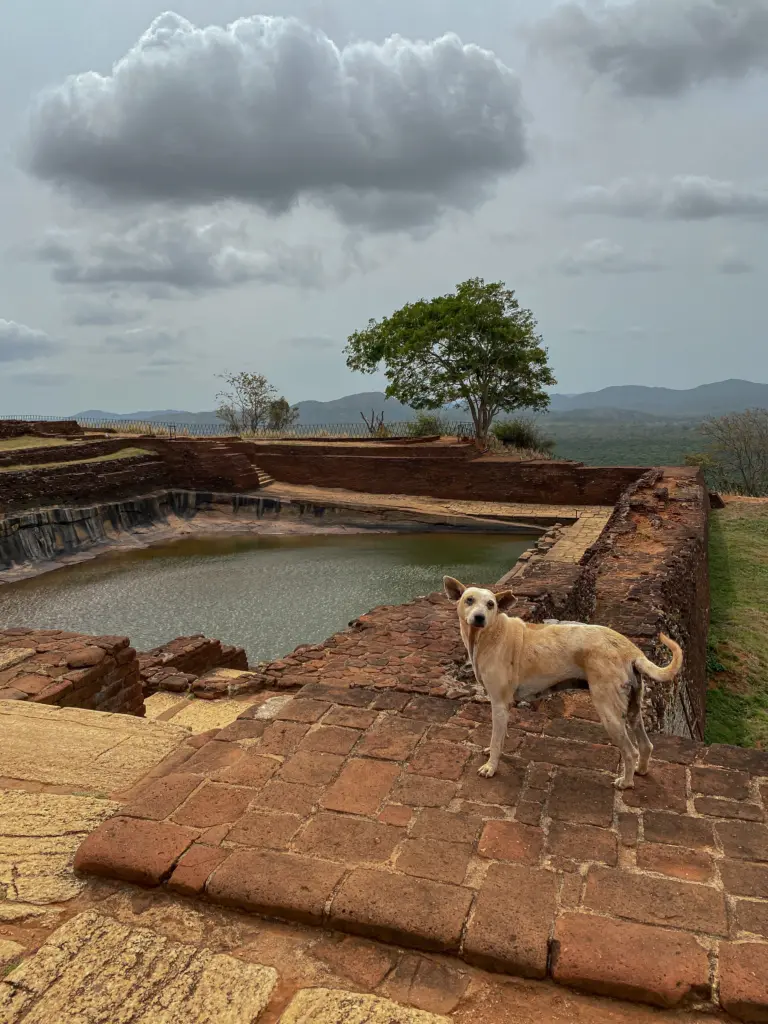
Lion Rock
History of Lion Rock
Sigiriya’s story begins over a millennium and a half ago, with a tale that is as much about royal ambition as it is about architectural marvel. King Kashyapa, seeking to secure his claim to the throne amidst a backdrop of betrayal and family rivalry, chose the towering rock of Sigiriya as his fortress in the late 5th century.
It wasn’t just a defensive move; it was a statement. By constructing his palace atop this massive column of rock, Kashyapa declared his power and divine right to rule.
The construction of Sigiriya was an unparalleled feat. Workers transformed the sheer cliffs into an impregnable fortress, complete with an elaborate gateway in the form of a massive lion, through which visitors would enter the royal domain. The summit was adorned with a palace, gardens, and ponds, showcasing sophisticated engineering and a deep appreciation for aesthetic beauty.
However, Sigiriya’s time as a royal residence was brief. After Kashyapa’s death, the site was repurposed as a Buddhist (Theravada) monastery, a role it continued to play until the 14th century.
At the heart of Sigiriya’s history is the legend of King Kashyapa himself. His ascent to power, marked by the controversial overthrow of his father, King Dhatusena, and the resulting conflict with his brother, Moggallana, sets the stage for Sigiriya’s creation. Despite his efforts, after Kashyapa’s defeat at the hands of Moggallana, Sigiriya gradually fell into disuse, its grandeur slowly reclaimed by the jungle.

How to Reach Lion Rock
Getting to Sigiriya is pretty simple with two convenient options – tuk-tuks and tours:
- Tuk-Tuks: These nimble three-wheelers are a staple on the roads of Sigiriya, offering an authentic and flexible way to move around. Ideal for short distances, tuk-tuks can easily take you from your accommodation to the base of Sigiriya Rock, Dambulla, and Pidurangala Rock. The cost is reasonable, with fares typically ranging from 200 LKR to 500 LKR for local trips. Always confirm the price with the driver before starting your journey to avoid any confusion.
- Organized Tours: For those looking to explore Sigiriya and its surrounding attractions without the hassle of planning every detail, joining a tour can be a great choice. Tours not only provide transport but also offer the insight of knowledgeable guides who can enhance your understanding of the area’s history. If you’re keen you can join a tour such as this one.

The Lion Rock Hike
The hike up Sigiriya is a bit strenuous but rewarding, offering unparalleled views and a unique insight into ancient Sri Lankan civilization. Start early to avoid the heat and the crowds.
At 495 m (1,624 ft) high, it takes around 3 hours to complete with plenty of time for rest and appreciating the ruins and sceneries.
Wear comfortable shoes, carry water, and don’t rush—take your time to absorb the history and beauty around you. The trail is mostly stairs with plenty of safety precautions in place.
At the base of Sigiriya, the Water Gardens showcase advanced hydraulic engineering and a deep appreciation for aesthetic landscape design. These gardens, with their sophisticated water retention and irrigation systems, reflect the harmony between architecture and nature in ancient Sri Lankan culture.
Halfway up, you’ll encounter the Mirror Wall, once polished to perfection. Today, it’s covered in inscriptions dating back as far as the 8th century.

As you climb higher, you’ll come across the famous Sigiriya Frescoes, exquisite depictions of celestial maidens.
The final ascent to the summit is through the Lion’s Gate, named for its massive lion paw sculptures. It’s around this point where I saw some signs for hornets and there were even some first aid centers so do be careful with the noise level in order to not aggravate the nasty bugs.

The Boulder Gardens, with their natural rock formations, were ingeniously integrated into the landscape design, while the Terraced Gardens, built into the slopes of the rock, served both as a functional space for crops and an aesthetic space for relaxation.
After finishing, you’ll descend on to the other side which where your tuk-tuk driver will wait for you. You still have a lot of time left in the day before sunset so I recommend making a short trip to Dambulla where there is still a lot to be seen! It’s exactly what I did and there was still more than enough time to spare for Pidurangala Rock. Polonnaruwa is also another possible destination.
Cost
It’s around 5,000 LKR (30 USD) to enter Sigiriya Rock Fortress which is a hefty price for some which is why a lot of people just opt to go to Pidurangala Rock. But why deprive yourself of visiting such a site though? The ruins and the whole experience of climbing Lion Rock is definitely one for the books and not to be missed.

Pidurangala Rock
History of Pidurangala Rock
Pidurangala Rock, while often overshadowed by its famous neighbor Sigiriya, has a rich history that is deeply intertwined with that of the Lion Rock itself.
The origins of Pidurangala date back to the first century BCE, when it was established as a Buddhist monastery. This came about when King Kashyapa, in his quest to build his fortress on Sigiriya, relocated the monks residing there to Pidurangala. In exchange, he commissioned the construction of a temple and monastery at Pidurangala, thus ensuring the monks had a new place of worship.
Over the centuries, Pidurangala evolved into a major monastic complex. The rock is home to a large reclining Buddha statue, which is believed to date back to the period immediately following King Kashyapa’s era.

How to Reach Pidurangala Rock
For Pidurangala Rock, it’s more or less the same as Sigiriya. It’s most accessible via tuk-tuk and from Dambulla or Sigiriya, you can easily take one.
You can also opt to join a tour that visits Pidurangala Rock.
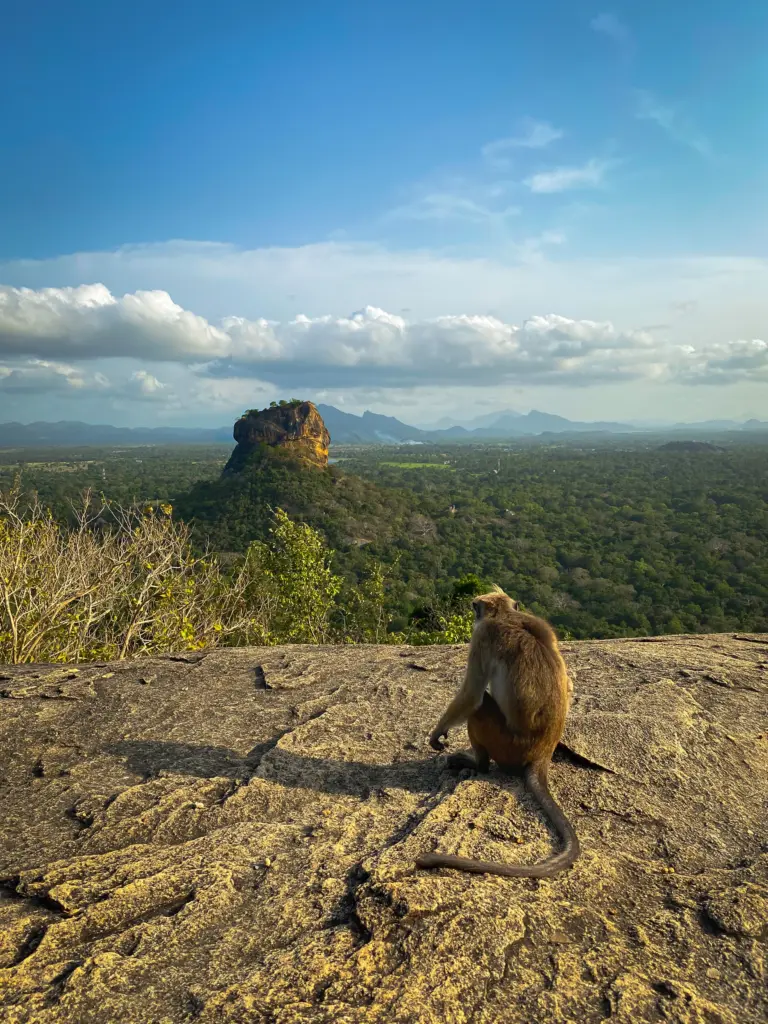
The Pidurangala Rock Hike
The trek to Pidurangala begins at the Pidurangala Sigiriya Rajamaha Viharaya, where a modest entrance fee contributes to the temple’s upkeep. The initial part of the hike is relatively easy, taking you through dense forest and past the ancient temple ruins.
With a height of 200 m (660 ft), you can expect around a 30 – 45 minute hike though I recommend starting at least 1 hour before sunset to have plenty of time to explore the cave temples and find a good spot for that optimal shot.
The climb becomes progressively steeper and more challenging, especially towards the summit, where you’ll need to navigate a section of natural rock and boulders. It’s advisable to wear sturdy footwear and bring along a bottle of water. The effort, however, is well worth it.
Halfway up the rock, you’ll encounter a large reclining Buddha statue, nestled in a cave.
The summit of Pidurangala offers a 360-degree view of the surrounding countryside, with Sigiriya Rock taking center stage.
Descending Pidurangala can be tricky due to the loose rocks and steep sections. Take your time and proceed with caution, especially if you’re making your way down as the light fades. It’s advisable to bring a head torch or perhaps to leave while the sun is setting.
Cost
For Pidurangala, it’s around 1,000 LKR (3 USD) to enter. A measly fee for incredible views.
The cave temples here are also worth checking out as it’s on the way to the top. Note that you would have to take off your shoes and cover up when entering the sacred grounds. I found that hiking while barefoot can be incredible grounding and immersive. There are also sarongs for rent at the ticket booth in case you can’t cover up.
Where to Stay in Sigiriya
Sigiriya is a great base to make if you’re exploring the Cultural Triangle. It’s close to other sites such as Polonnaruwa and Dambulla, and public transport available connecting to Colombo.
There are also plenty of safaris that are easily reachable such as Habarana and Minneriya. Here are some of the most recommended places to stay in Sigiriya:
Best Hotels in Sigiriya:
- Palitha Homestay – offers a unique lodging experience with its fan-cooled rooms that boast garden views and come equipped with mosquito nets for a comfortable stay. You can enjoy the convenience of complimentary in-room WiFi and free private parking. The rooms include attached bathrooms fitted with shower amenities, toiletries, and a spray bidet for added comfort.
- Liyon Rest – offers a tranquil accommodation experience with air-conditioned rooms that ensure a secure stay thanks to in-room safety deposit boxes. You’ll have access to free WiFi throughout their stay. The private bathrooms are well-appointed with showers and complimentary toiletries. From the comfort of your room, you can admire scenic views of the lake and mountains.
- Sigiriya Water Cottage – provides a serene retreat complete with a barbecue and sun terrace. Each room in this hotel is air-conditioned for comfort and is equipped with a flat-screen TV with satellite channels, allowing you to relax with a cup of coffee while enjoying views of the mountains or lake. Complimentary WiFi and private parking are added conveniences.
Best Hostels in Sigiriya:
- Tree House Hostel Sigiriya – extends a warm invitation to guests from around the globe, encouraging them to “come as a guest, go as a friend.” This unique hostel offers accommodation in tree houses, complete with a serene garden and complimentary private parking for those arriving by car.
- Roy’s Villa Hostel – offers a unique retreat for nature lovers, surrounded by wildlife including monkeys, birds, and bugs, and boasting breathtaking views of Lion Rock and Pidurangala Rock, as well as serene lakeside vistas accessible through picturesque rice fields. Roy’s Villa provides delicious vegan and native dishes prepared by local cooks, alongside free activities like cooking demonstrations and sunset walks.
- Mango Tree Home Stay – discover the warmth of authentic Sri Lankan hospitality by staying with a local family, offering the privacy of your own room amidst a lush landscape of mango and coconut trees. This unique homestay is perfectly situated for exploring the area’s natural and historical wonders.

Best Time to Visit Sigiriya
The best time to visit Sigiriya is during the dry season from January to April. During this time, you can expect sunny and pleasant weather, perfect for outdoor activities like climbing Sigiriya Rock or going on safaris. Temperatures hover around 22°C – 31°C (72°F – 88°F).
This period ensures clear skies and minimal rainfall, allowing you to fully enjoy the natural beauty and historical sites of Sigiriya without the interruption of heavy rains.
What to Pack for the Hike
Preparing for a hike to either Sigiriya Lion Rock or Pidurangala Rock requires some essential gear to ensure a safe and enjoyable experience. Here’s a list of must-have items to pack:
Water: Staying hydrated is crucial, especially in Sri Lanka’s warm climate. Bring at least 1-2 liters of water per person to ensure you have enough for the climb and descent.
Head Torch: A head torch is particularly important for Pidurangala Rock for either sunrise or sunset. The paths can be dark and uneven, making a hands-free light source invaluable.
Sun Protection: The sun can be intense, even in the early morning or late afternoon. Pack sunscreen with high SPF, a hat, and sunglasses to protect yourself from sunburn and glare.
Good Shoes: Both hikes involve uneven terrain and, in the case of Pidurangala, some scrambling over rocks. Wear comfortable, sturdy shoes with good grip to prevent slips and falls.
Snacks: Energy-boosting snacks like nuts, fruit, or granola bars can be a welcome pick-me-up during the hike or a reward at the summit.
Insect Repellent: Mosquitoes and other insects can be a nuisance, especially at lower elevations and near water sources. Apply insect repellent to avoid bites.
Plan Your Trip to Sri Lanka | Best Travel Resources
Book Your Accommodations
- Booking.com – the world’s leading online booking platform for accomodations around the world, they have an extensive amount of available listings with zero booking fees and best price guarantees.
- Hostelworld – a backpacker’s best friend, Hostelworld has the largest collection of hostels and guesthouses for affordable prices.
Don’t Forget Insurance
- SafetyWing – from Nomad Insurance, an insurance by nomads for nomads. They understand our lifestyle well and have really comprehensive and flexible plans that cater to any traveler.
Find Cheap Flights
- Kiwi.com – my go-to for booking and finding the cheapest flights and it’s helped me save tons of money. They do virtual interlining which is connecting flights from airlines that do not codeshare, so you can find routes that you wouldn’t be able to find normally.
Join Tours & Activities
- GetYourGuide – is one of the best places to find unique tours and activities. I found that it’s an excellent way to meet fellow travelers and create fond memories. They are not only limited to tours as they also offer niche services such as skip-the-line tickets or private transfers.
Catch a Ride
- Rentalcars.com – nothing beats the freedom of the road, Rentalcars.com is the world’s largest online car rental service. They operate across 160 countries so they’re the perfect partner to work with if you find yourself wanting a ride.


